Comparative Study of the Impact of Bio-Sourced and Recycled Insulation Materials on Energy Efficiency in Office Buildings in Burkina Faso
Abstract
:1. Introduction
2. Literature Review
3. Materials and Methods
- First Round: It focused on walls. The base case wall was used as the first case to simulate, with the following cases representing each building insulating material used in this research. Based on the results, the material which performed the best was kept for the second stage of the simulations.
- Second round: Using the best wall insulation material from the previous stage of simulations, other cases were added, representing the use of the bio-sourced and recycled insulating materials studied in this research to focus on the roof, ceilings, and internal floors.
3.1. Computational Simulation Base Case
3.2. Insulation Materials and Thermophysical Properties
3.3. Ouagadougou Climate Data
3.4. Thermal Comfort and Occupancy
3.5. EnergyPlus Simulations and Input Parameters
4. Results
4.1. First Round: Wall Insulation
4.1.1. Heat Transfer through Walls
4.1.2. Discomfort Degree Hours
4.1.3. Energy Consumption
4.2. Second Round: Roof and Internal Floors Insulation
4.2.1. Heat Transfer through Roof and Internal Floors
4.2.2. Discomfort Degree Hours
4.2.3. Energy Consumption
5. Discussions
5.1. Importance of Office Building Insulation
5.2. Bio-Sourced and Recycled Insulation Materials as Renewable Materials
- Straw bales: Even though they may (and should) be pushed back into the soil to promote soil fertility, many farmers burn their excess straw. Instead of burning straw to prepare fields for later harvests, straw bales may play a crucial role in the shift to ecological construction options.
- Reed: The common reed is an invasive plant that grows naturally in wetlands, such as ponds or along the sides of lakes or rivers; it does not need any treatment, merely good climatic and environmental circumstances.
- Hemp wool: Industrial hemp is non-intoxicating (0.3% tetrahydrocannabinol or THC) and renewable. It does not need herbicides or pesticides to grow [66].
- Recycled glass wool: It is recycled material from waste printed circuit boards (WPCB) used as sound absorption and thermal insulation material. Glass wool was obtained through a fluidized-bed recycling process [68].
5.3. Supportive Policies to Promote Bio-Based and Recycled Insulation Materials to Invigorate a Circular Economy in Burkina Faso
5.4. Future Research
- Firstly, additional experimental investigations are needed to confirm whether or not the insulation materials perform well for the outer walls and for the interior parts of buildings.
- Secondly, the choice of the overall best bio-sourced and recycled insulation materials also needs to consider the initial cost. Future research should focus on comparing the initial cost of implementing these locally insulation materials with the cost savings from the energy reduction they would provide to see when and which insulation is the most profitable.
- In addition, it is recommended that the same approach be employed in other places with similar weather patterns and that benchmarking be undertaken among the sub-Saharan regions.
- Finally, future studies should also investigate how mathematics may be utilized to construct algorithms that determine the optimal insulating material thickness based on life cost analysis and performance in sub-Saharan nations.
6. Conclusions
- Located in Ouagadougou (12.353° N, 1.512° W, and 316 m above sea level), a four-story “H”-shaped office building made of cement blocks with a fixed north–south orientation, a 30% wwr with single RAL blue-tinted 6 mm windows with standard horizontal louvers used as the shading device and was used as a base case to conduct the research.
- In the first round, hemp wool was the best performing bio-sourced insulation material to use on walls, providing 11.3% and 15.3% of annual energy demand and cooling energy demand, respectively.
- Hemp wool had the least annual heat transfer on the wall, 12,583 kWh, which represents a 90.86% reduction and contributes to reducing the DDH by 12.6%.
- The outcomes of the second round of simulations also confirmed hemp wool as the best-performing bio-sourced insulation material for roof and internal floors, helping to reduce 17.7% and 25.8% annual energy consumption and annual cooling energy demand, respectively.
- Hemp wool impacted the heat transfer of the roof and internal floors by an 85.1% and 88.1% reduction, respectively, while the DDH was reduced by 17.6%.
- Overall, all the insulation materials studied in this paper had some performances that were more or less within the same range without any vast differences.
- The availability of these bio-based and recycled insulation materials may also serve as proof to foster a circular economy in Burkina Faso’s construction industry.
Author Contributions
Funding
Acknowledgments
Conflicts of Interest
Nomenclature
| XPS | extruded polystyrene |
| THC | tetrahydrocannabinol |
| DDH | discomfort degree hours |
| KWh | kilowatt-hour |
| WPCB | waste printed circuit boards |
| SHGC | solar heat gain coefficient |
| TRY | test reference year |
| HVAC | heating ventilation and air conditioning |
| PMV | predicted mean vote |
| WWR | windows-to-wall ratio |
| VLT | visible light transmittance |
| EPW | EnergyPlus weather |
| PPD | predicted percentage of dissatisfied |
| ASHRAE | American Society of Heating, Refrigerating, and Air-Conditioning Engineers |
References
- Byadgi, S.A.; Kalburgi, P.B. Production of bioethanol from waste newspaper. Procedia Environ. Sci. 2016, 35, 555–562. [Google Scholar] [CrossRef]
- IPCC. Global Warming of 1.5 °C. An IPCC Special Report on the Impacts of Global Warming of 1.5 °C Above Pre-Industrial Levels and Related Global Greenhouse Gas Emission Pathways, in the Context of Strengthening the Global Response to the Threat of Climate Change, Sustainable Development, and Efforts to Eradicate Poverty. Press: 2018. Available online: https://www.ipcc.ch/sr15/ (accessed on 9 August 2022).
- Tyagi, V.; Kaushik, S.; Tyagi, S.; Akiyama, T. Development of phase change materials based microencapsulated technology for buildings: A review. Renew. Sustain. Energy Rev. 2011, 15, 1373–1391. [Google Scholar] [CrossRef]
- Ramakrishnan, S.; Wang, X.; Sanjayan, J.; Wilson, J. Thermal performance of buildings integrated with phase change materials to reduce heat stress risks during extreme heatwave events. Appl. Energy 2017, 194, 410–421. [Google Scholar] [CrossRef]
- Niemann, P.; Schmitz, G. Impacts of occupancy on energy demand and thermal comfort for a large-sized administration building. Build. Environ. 2020, 182, 107027. [Google Scholar] [CrossRef]
- Waqas, A.; Din, Z.U. Phase change material (PCM) storage for free cooling of buildings—A review. Renew. Sustain. Energy Rev. 2013, 18, 607–625. [Google Scholar]
- ASivanathan, A.; Dou, Q.; Wang, Y.; Li, Y.; Corker, J.; Zhou, Y.; Fan, M. Phase change materials for building construction: An overview of nano-/micro-encapsulation. Nanotechnol. Rev. 2020, 9, 896–921. [Google Scholar] [CrossRef]
- (International Energy Agency) IEA. Africa Energy Outlook: World Energy Outlook Special Report; IEA: Paris, France, 2019. [Google Scholar]
- Toguyeni, D.; Coulibaly, O.; Ouedraogo, A.; Koulidiati, J.; Dutil, Y.; Rousse, D. Study of the influence of roof insulation involving local materials on cooling loads of houses built of clay and straw. Energy Build. 2012, 50, 74–80. [Google Scholar] [CrossRef]
- Zhang, Y.; He, C.-Q.; Tang, B.-J.; Wei, Y.-M. China’s energy consumption in the building sector: A life cycle approach. Energy Build. 2015, 94, 240–251. [Google Scholar] [CrossRef]
- Ye, Z. The Development Status and Trend of Prefabricated Composite Wallboard of Industrialization of Construction Industry. Fujian Constr. Sci. Technol. 2016, 1, 28–30. [Google Scholar]
- Guglielmini, G.; Magrini, U.; Nannei, E. The influence of the thermal inertia of building structures on comfort and energy consumption. J. Therm. Insul. 1981, 5, 59–72. [Google Scholar] [CrossRef]
- Kristak, L.; Ruziak, I.; Tudor, E.M.; Barbu, M.C.; Kain, G.; Reh, R. Thermophysical Properties of Larch Bark Composite Panels. Polymers 2021, 13, 2287. [Google Scholar] [CrossRef] [PubMed]
- Pérez, G.; Coma, J.; Martorell, I.; Cabeza, L.F. Vertical Greenery systems (VGS) for energy saving. Renew. Sust. Energy Rev. 2014, 39, 139–165. [Google Scholar] [CrossRef]
- Sheweka, S.M.; Mohamed, N.M. Green Facades as a New Sustainable Approach Towards Climate Change. Energy Procedia 2012, 18, 507–520. [Google Scholar] [CrossRef] [Green Version]
- Azkorra, Z.; Pérez, G.; Coma, J.; Cabeza, L.F.; Bures, S.; Álvaro, J.E.; Erkoreka, A.; Urrestarazu, M. Evaluation of green walls as a passive acoustic insulation system for buildings. Appl. Acoust. 2015, 89, 46–56. [Google Scholar] [CrossRef] [Green Version]
- Rabbat, C.; Awad, S.; Villot, A.; Rollet, D.; Andrès, Y. Sustainability of biomass-based insulation materials in buildings, Current status in France, end-of-life projections and energy recovery potentials. Renew. Sustain. Energy Rev. 2022, 156, 111962. [Google Scholar] [CrossRef]
- Pritchard, M.; Pitts, A. Evaluation of strawbale building: Benefits and risks. Architect. Sci. Rev. 2006, 49, 372–384. [Google Scholar] [CrossRef]
- Samuel, D.; Arnaud, E.; Christophe, B.; Frédéric, L. Temperature and moisture storage in crop-based materials: Modelling a straw bale wall subject to a thermal shock. J. Build. Phys. 2016, 39, 421–439. [Google Scholar] [CrossRef]
- Douzane, O.; Promis, G.; Roucoult, J.-M.; Le, A.-D.T.; Langlet, T. Hygrothermal performance of a straw bale building: In situ and laboratory investigations. J. Build. Eng. 2016, 8, 91–98. [Google Scholar] [CrossRef]
- D’Alessandro, F.; Bianchi, F.; Baldinelli, G.; Rotili, A.; Schiavoni, S. Straw bale constructions: Laboratory, in field and numerical assessment of energy and environmental performance. J. Build. Eng. 2017, 11, 56–68. [Google Scholar] [CrossRef]
- Tiskatine, R.; Bougdour, N.; Oaddi, R.; Gourdo, L.; Rahib, Y.; Bouzit, S.; Bazgaou, A.; Bouirden, L.; Ihlal, A.; Aharoune, A. Thermo-physical analysis of low-cost ecological composites for building construction. J. Build. Eng. 2018, 20, 762–775. [Google Scholar] [CrossRef]
- Quagliarini, E.; Lenci, S. The influence of natural stabilizers and natural fibres on the mechanical properties of ancient Roman adobe bricks. J. Cult. Herit. 2010, 11, 309–314. [Google Scholar] [CrossRef]
- Aouba, L.; Coutand, M.; Perrin, B.; Lemercier, H. Predicting thermal performance of fired clay bricks lightened by adding organic matter: Improvement of brick geometry. J. Build. Phys. 2015, 38, 531–547. [Google Scholar] [CrossRef]
- Moreno-Rangel, A.; Tsekleves, E.; Vazquez, J.M.; Schmetterer, T. The Little Book of Bio-Based Fibre Materials in Passivhaus Construction in Latin America; Lancaster University: Lancaster, UK, 2021; pp. 15–16. [Google Scholar]
- Panyakaev, S.; Fotios, S. 321: Agricultural Waste Materials as Thermal insulation Dwellings in Thailand: Preliminary Results. In Proceedings of the 25th Conference on Passive and Low Energy Architecture, Dublin, Ireland, 22–24 October 2008. [Google Scholar]
- Korjenic, A.; Petranek, V.; Zach, J.; Hroudova, J. Development and performance evaluation of natural thermal-insulation materials composed of renewable resources. Energy Build. 2011, 43, 2518–2523. [Google Scholar] [CrossRef]
- Ninikas, K.; Mitani, A.; Koutsianitis, D.; Ntalos, G.; Taghiyari, H.R.; Papadopoulos, A.N. Thermal and Mechanical Properties of Green Insulation Composites Made from Cannabis and Bark Residues. J. Compos. Sci. 2021, 5, 132. [Google Scholar] [CrossRef]
- Asdrubali, F.; D’Alessandro, F.; Schiavoni, S. A review of unconventional sustainable building insulation materials. SMT 2015, 4, 1–17. [Google Scholar] [CrossRef]
- Zhang, S.Y.; Li, Y.Y.; Wang, C.G.; Wang, X. Thermal Insulation Boards from Bamboo Paper Sludge. Bioresources 2017, 12, 56–67. [Google Scholar] [CrossRef] [Green Version]
- Kain, G.; Barbu, M.C.; Hinterreiter, S.; Richter, K.; Petutschnigg, A. Using Bark as a Heat Insulation Material. Bioresources 2013, 8, 3718–3731. [Google Scholar] [CrossRef]
- Ninikas, K.; Ntalos, G.; Hytiris, N.; Skarvelis, M. Thermal Properties of Insulation Boards Made of Tree Bark & Hemp Residues. J. Sustain. Archit. Civ. Eng. 2019, 24, 71–77. [Google Scholar]
- Kain, G.; Tudor, E.M.; Barbu, M.C. Bark Thermal Insulation Panels: An Explorative Study on the Effects of Bark Species. Polymers 2020, 12, 2140. [Google Scholar] [CrossRef]
- Euring, M.; Kirsch, A.; Kharazipour, A. Hot-Air/Hot-Steam Process for the Production of Laccase-Mediator-System Bound Wood Fiber Insulation Boards. Bioresources 2015, 10, 3541–3552. [Google Scholar] [CrossRef] [Green Version]
- Gößwald, J.; Barbu, M.C.; Petutschnigg, A.; Tudor, E.M. Binderless Thermal Insulation Panels Made of Spruce Bark Fibres. Polymers 2021, 13, 1779. [Google Scholar] [CrossRef] [PubMed]
- Patnaik, A.; Mvubu, M.; Muniyasamy, S.; Botha, A. Thermal and sound insulation materials from waste wool and recycled polyester fibers and their biodegradation studies. Energy Build. 2015, 92, 161–169. [Google Scholar] [CrossRef]
- Pennacchio, R.; Savio, L.; Bosia, D.; Thiebat, F.; Piccablotto, G.; Patrucco, A.; Fantucci, S. Fitness: Sheep-wool and hemp sustainable insulation panels. Energy Procedia 2017, 111, 287–297. [Google Scholar] [CrossRef]
- Akcagun, E.; Boguslawska-Baczek, M.; Hes, L. Thermal insulation and thermal contact properties of wool and wool/PES fabrics in wet state. J. Nat. Fibers 2019, 16, 199–208. [Google Scholar] [CrossRef]
- Zach, J.; Korjenic, A.; Petranek, V.; Hroudova, J.; Bednar, T. Performance evaluation and research of alternative thermal insulation based on sheep wool. Energy Build. 2012, 49, 246–253. [Google Scholar] [CrossRef]
- Cuce, E.; Cuce, P.M.; Wood, C.J.; Riffat, S.B. Optimizing insulation thickness and analysing environmental impactsof aerogel-based thermal superinsulation in buildings. Energy Build. 2014, 77, 28–39. [Google Scholar] [CrossRef]
- Ziapour, B.M.; Rahimi, M.; Gendeshmin, M.Y. Thermoeconomic analysis for determining optimal insulation thickness for new composite prefabricated wall block as an external wall member in buildings. J. Build. Eng. 2020, 31, 101354. [Google Scholar] [CrossRef]
- Yamankaradeniz, N. Minimization of thermal insulation thickness taking into account condensation on external walls. Adv. Mech. Eng. 2015, 7, 1687814015604803. [Google Scholar] [CrossRef] [Green Version]
- Kaya, S.; Oguz, M.E. Tesisat yalıtımında uygun malzeme seçimi. In Proceedings of the Ulusal Tesisat Kongresi Ve Sergisi (TESKON), Yalıtım Semineri, Izmir, Turkey, 8–11 April 2015; pp. 2483–2496. [Google Scholar]
- Ibrahim, M.; Biwole, P.H.; Achard, P.; Wurtz, E.; Ansart, G. Building envelope with a new aerogel-based insulating rendering: Experimental and numerical study, cost analysis, and thickness optimization. Appl. Energy 2015, 159, 490–501. [Google Scholar] [CrossRef]
- Huang, H.; Zhou, Y.; Huang, R.; Wu, H.; Sun, Y.; Huang, G.; Xu, T. Optimum insulation thicknesses and energy conservation of building thermal insulation materials in Chinese zone of humid subtropical climate. Sustain. Cities Soc. 2020, 52, 101840. [Google Scholar] [CrossRef]
- Kurekci, N.A. Determination of optimum insulation thickness for building walls by using heating and cooling degree-day values of all Turkey’s provincial centers. Energy Build. 2016, 118, 197–213. [Google Scholar] [CrossRef]
- Dlimi, M.; Iken, O.; Agounoun, R.; Zoubir, A.; Kadiri, I.; Sbai, K. Energy performance and thickness optimization of hemp wool insulation and air cavity layers integrated in Moroccan building walls. Sustain. Prod. Consum. 2019, 20, 273–288. [Google Scholar] [CrossRef]
- Kon, O.; Caner, I.; Arda, S. Investigation of using hemp as a thermal insulation material in the building envelope in terms of thermal comfort. In Proceedings of the 12th International Exergy, Energy and Environment Symposium (IEEES-12), Doha, Qatar, 20–24 December 2020; pp. 1–4. [Google Scholar]
- Mirsadeghi, M.; Cóstola, D.; Blocken, B.; Hensen, J.L.M. Review of external convective heat transfer coefficient models in building energy simulation programs: Implementation and uncertainty. Appl. Therm. Eng. 2013, 56, 134–151. [Google Scholar] [CrossRef]
- Alghoul, S.K.; Gwesha, A.O.; Naas, A.M. The Effect of Electricity Price on Saving Energy Transmitted from External Building Walls. Int. J. Energy Res. 2016, 7, 1–9. [Google Scholar] [CrossRef] [Green Version]
- Adegun, B.; Adedeji, Y. Review of economic and environmental benefits of earthen materials for housing in Africa. Front. Archit. Res. 2017, 6, 519–528. [Google Scholar] [CrossRef]
- Sore, S.O.; Messan, A.; Prud’homme, E.; Escadeillas, G.; Tsobnang, F. Stabilization of compressed earth blocks (CEBs) by geopolymer binder based on local materials from Burkina-Faso. Construct. Build. Mater. 2018, 165, 333–345. [Google Scholar] [CrossRef]
- Yézouma, C.; Godefroy, T.; Yves, T.M. Climat et confort thermique. Sud. Sci. Technol. 1998, 2, 6. [Google Scholar]
- Jannot, Y.; Djiako, T. Economie d’énergie et confort thermique dans l’habitat en Zone tropicale. Rev. Int. Froid 1994, 17, 166–173. [Google Scholar] [CrossRef]
- Hema, C.; Van Moeseke, G.; Evrad, A.; Courard, L.; Messan, A. Vernacular housing practices in Burkina Faso: Representative models of construction in Ouagadougou and walls hygrothermal efficiency. Energy Procedia 2017, 122, 535–540. [Google Scholar] [CrossRef]
- Toure, P.; Dieye, Y.; Gueye, P.M.; Faye, M.; Sambou, V. Influence of envelope thickness and solar absorptivity of a test cell on time lag and decrement factor. J. Build. Phys. 2019, 43, 338–350. [Google Scholar] [CrossRef]
- Neya, I.; Yamegueu, D.; Coulibaly, Y.; Messan, A.; Ouedraogo, A.L.S.-N. Impact of insulation and wall thickness in compressed earth buildings in hot and dry tropical regions. J. Build. Eng. 2021, 33, 101612. [Google Scholar] [CrossRef]
- Offerle, B.; Jonsson, P.; Eliasson, I.; Grimmond, C.S.B. Urban modification of the surface energy balance in the West African Sahel: Ouagadougou, Burkina Faso. J. Clim. 2005, 18, 3983–3995. [Google Scholar] [CrossRef]
- Zoure, A.N.; Genovese, P.V. Development of Bioclimatic Passive Designs for Office Building in Burkina Faso. Sustainability 2022, 14, 4332. [Google Scholar] [CrossRef]
- Sassoni, E.; Manzi, S.; Motori, A.; Montecchi, M.; Canti, M. Experimental study on the physical–mechanical durability of innovative hemp-based composites for the building industry. Energy Build. 2015, 104, 316–322. [Google Scholar] [CrossRef]
- Binici, H.; Aksogan, O.; Demirhan, C. Mechanical, thermal and acoustical characterizations of an insulation composite made of bio-based materials. Sustain. Cities Soc. 2016, 20, 17–26. [Google Scholar] [CrossRef]
- La Rosa, A.D.; Recca, A.; Gagliano, A.; Summerscales, J.; Latteri, A.; Cozzo, G.; Cicala, G. Environmental impacts and thermal insulation performance of innovative composite solutions for building applications. Construct. Build. Mater. 2014, 55, 406–414. [Google Scholar] [CrossRef]
- Cetiner, I.; Shea, A.D. Wood waste as an alternative thermal insulation for buildings. Energy Build. 2018, 168, 374–384. [Google Scholar] [CrossRef]
- Lopez Hurtado, P.; Rouilly, A.; Vandenbossche, V.; Raynaud, C. A review on the properties of cellulose fibre insulation. Build. Environ. 2016, 96, 170–177. [Google Scholar] [CrossRef] [Green Version]
- Khir, R.; Pan, Z. Chapter 2—Rice. In Integrated Processing Technologies for Food and Agricultural By-Products; Academic Press: Cambridge, MA, USA, 2019; pp. 21–58. ISBN 9780128141380. Available online: https://www.sciencedirect.com/science/article/pii/B9780128141380000022 (accessed on 14 August 2022). [CrossRef]
- InterChanvre Fichaux, N.; Briffaud, D. Dossier de Presse de L’interprofession du Chanvre au SIA. 2018. Available online: https://www.interchanvre.org/documents/5.actu_presse/communiques_de_presse/201802_Dossier_Press_InterChanvre.pdf (accessed on 14 August 2022).
- Miljan, M.; Miljan, M.-J.; Miljan, J.; Akermann, K.; Karja, K. Thermal transmittance of reed-insulated walls in a purpose-built test house. Mires Peat 2013, 13, 1–12. [Google Scholar]
- Sun, Z.; Shen, Z.; Ma, S.; Zhang, X. Novel Application of Glass Fibers Recovered From Waste Printed Circuit Boards as Sound and Thermal Insulation Material. J. Mater. Eng. Perform. 2013, 22, 3140–3146. [Google Scholar] [CrossRef] [Green Version]
- Turku, I.; Kasala, S.; Kärki, T. Characterization of Polystyrene Wastes as Potential Extruded Feedstock Filament for 3D Printing. Recycling 2018, 3, 57. [Google Scholar] [CrossRef] [Green Version]
- ANSI/ASHRAE Standard 55-2017; Thermal Environmental Conditions for Human Occupancy. ASHRAE: Peachtree Corners, GA, USA, 2020. Available online: https://www.ashrae.org/file%20library/technical%20resources/standards%20and%20guidelines/standards%20addenda/55_2017_d_20200731.pdf (accessed on 17 August 2022).
- Papparelli, A.; Cdnsulo, M. Strategies for bioclimatic design in an urban area of an arid zone: San Juan (Argentina). Landsc. Urban Plan. 1996, 34, 19–25. [Google Scholar] [CrossRef]
- Al-Zuhair, M.; Sayigh, A.A.M. Designing for comfort in Iraq. Sol. Wind Technol. 1989, 4, 369–382. [Google Scholar] [CrossRef]
- De Dear, R.; Brager, G.S. Developing an adaptive model of thermal comfort and preference. ASHRAE Trans. 1998, 104, 145–167. [Google Scholar]
- Elshafei, G.; Vilcekova, S.; Zelenakova, M.; Negm, A.M. Towards an Adaptation of Efficient Passive Design for Thermal Comfort Buildings. Sustainability 2021, 13, 9570. [Google Scholar] [CrossRef]
- Burkina-Faso Electricity Prices. 2022. Available online: https://fr.globalpetrolprices.com/Burkina-Faso/electricity_prices (accessed on 29 August 2022).
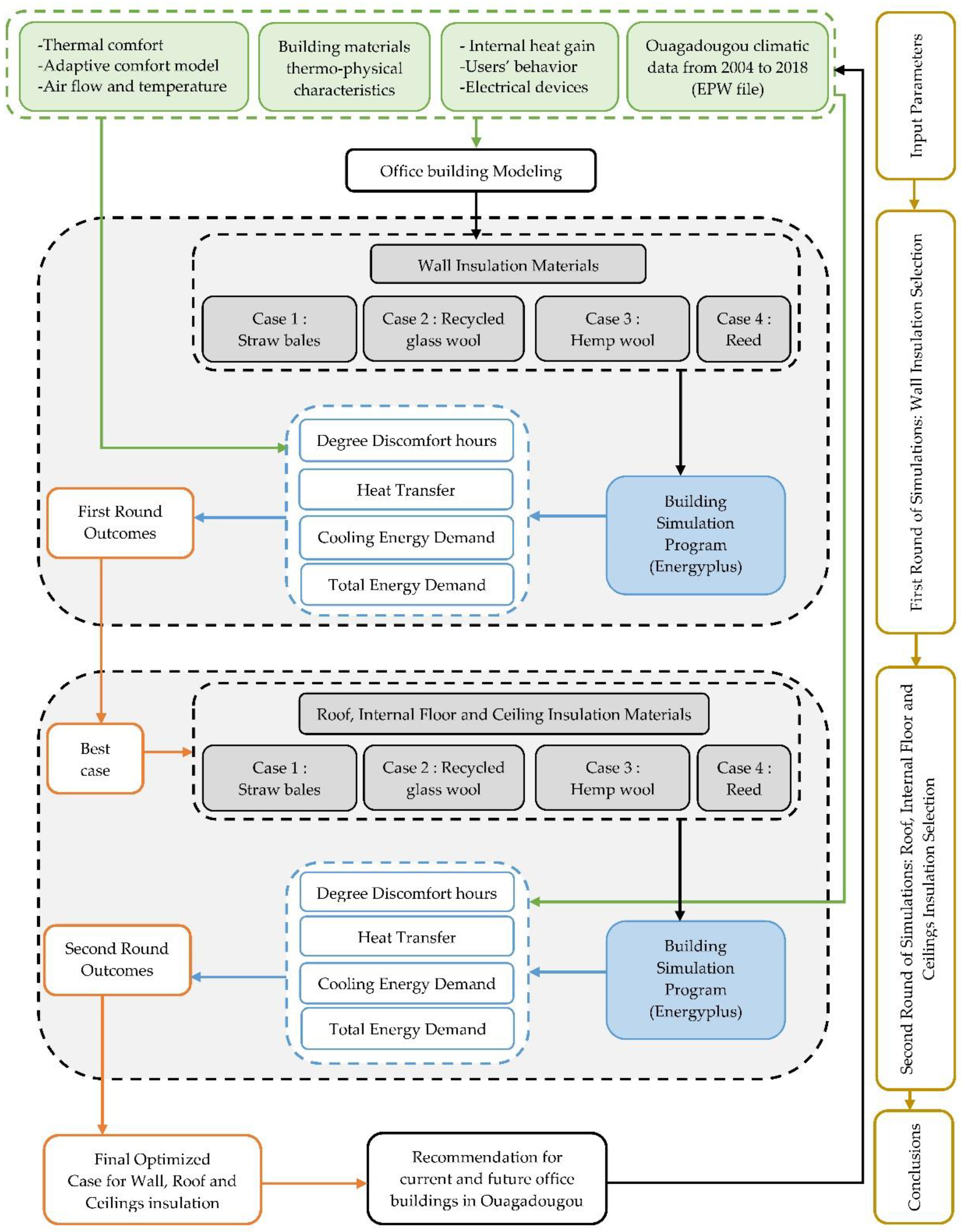

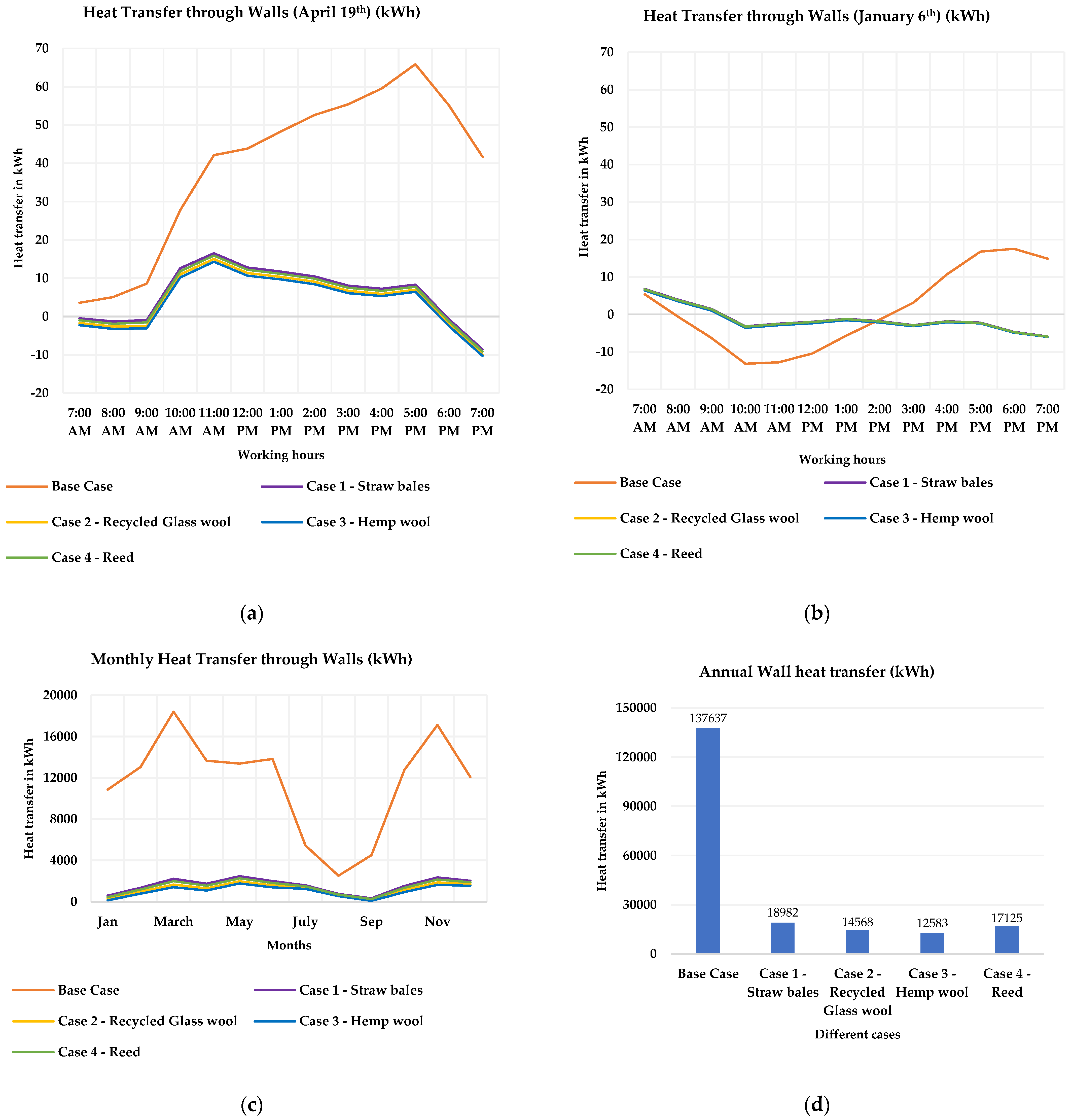
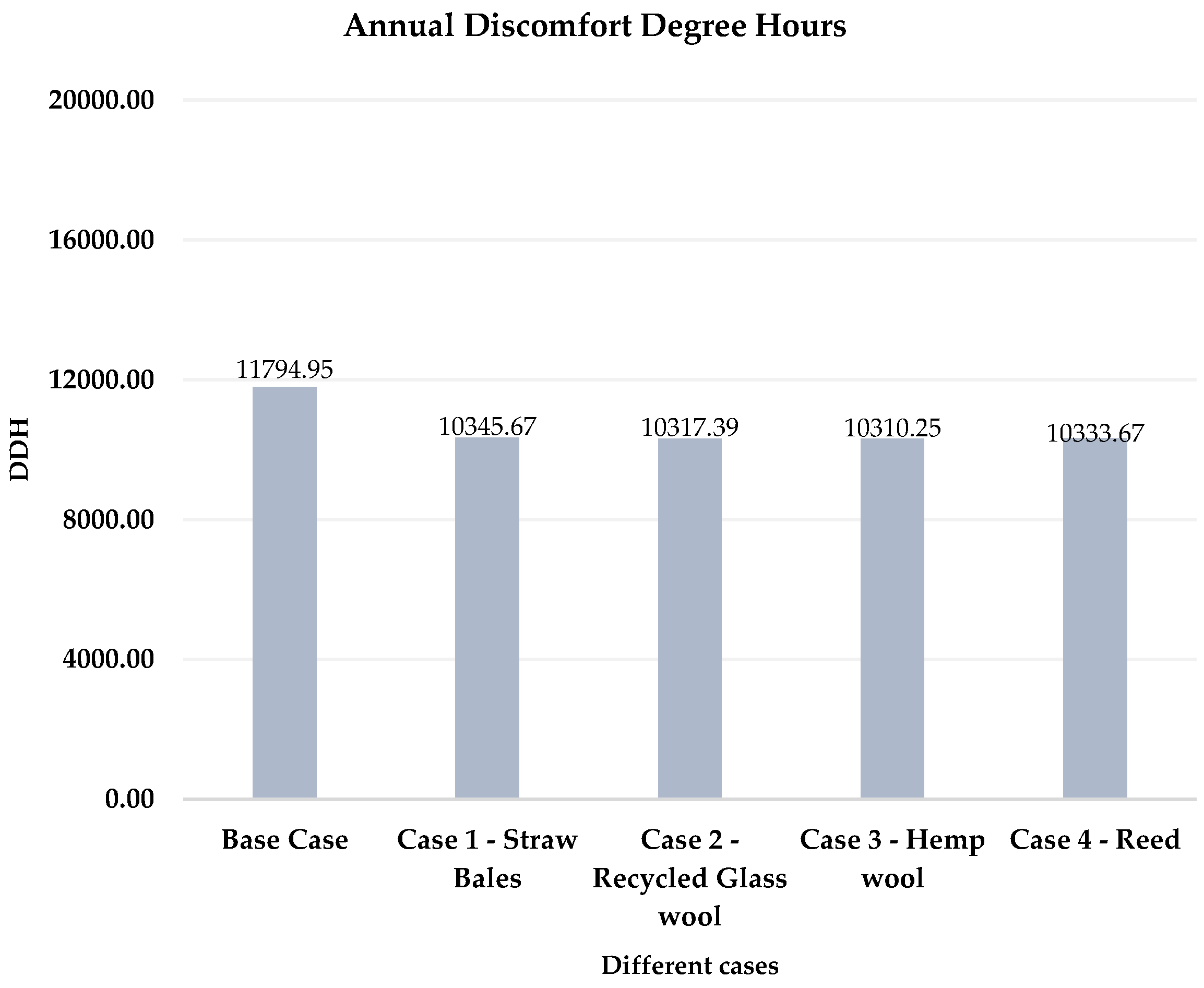
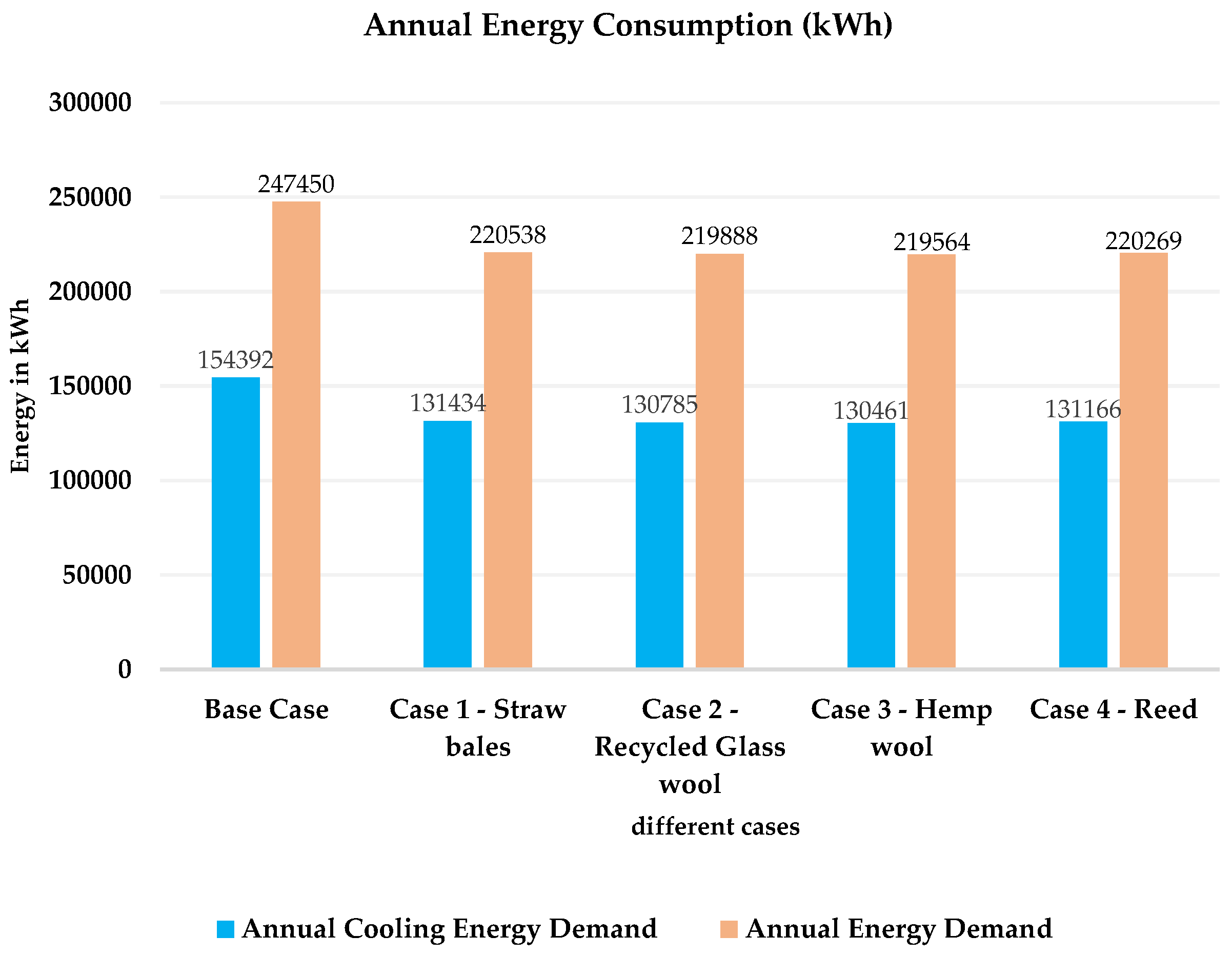
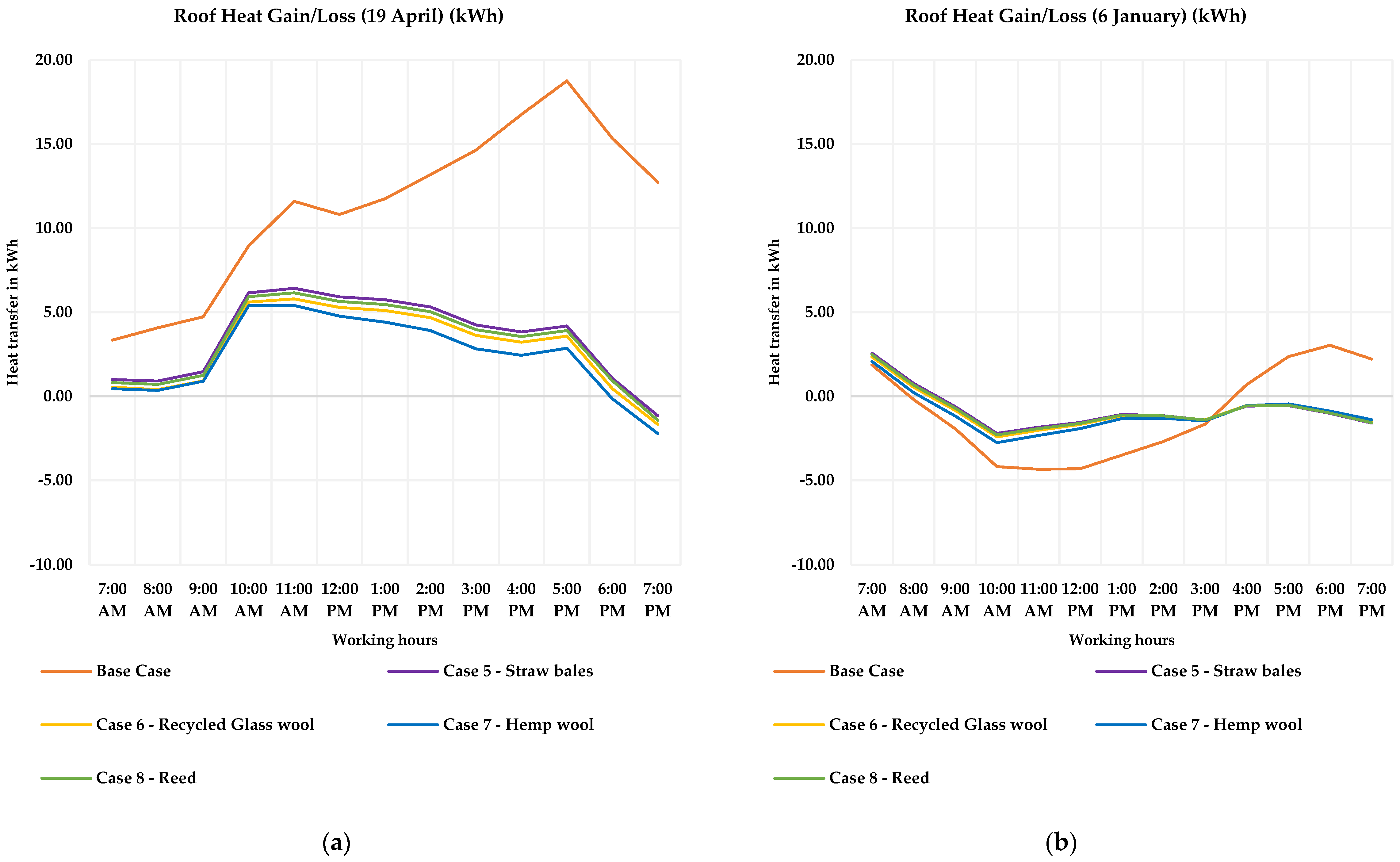
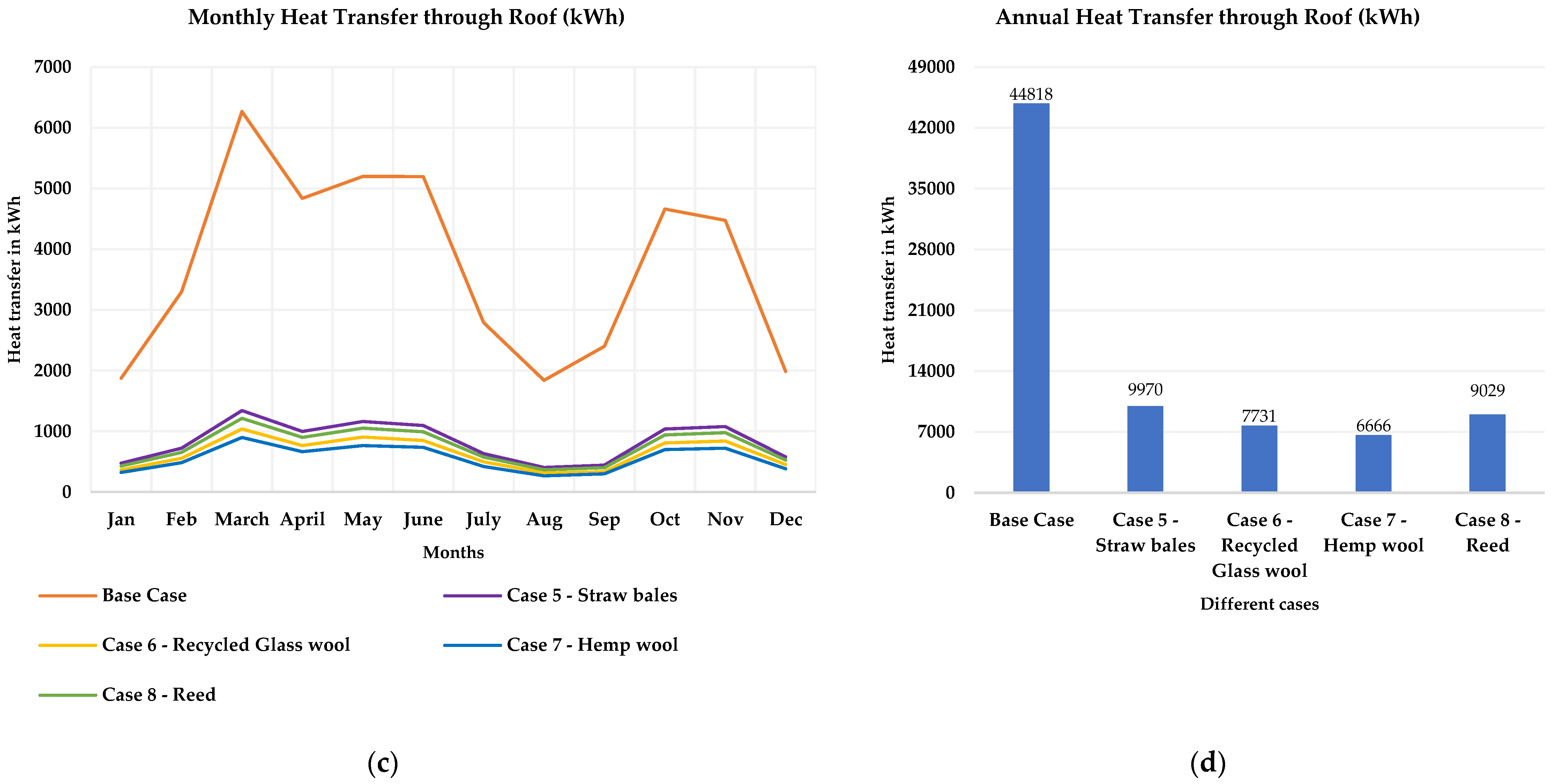
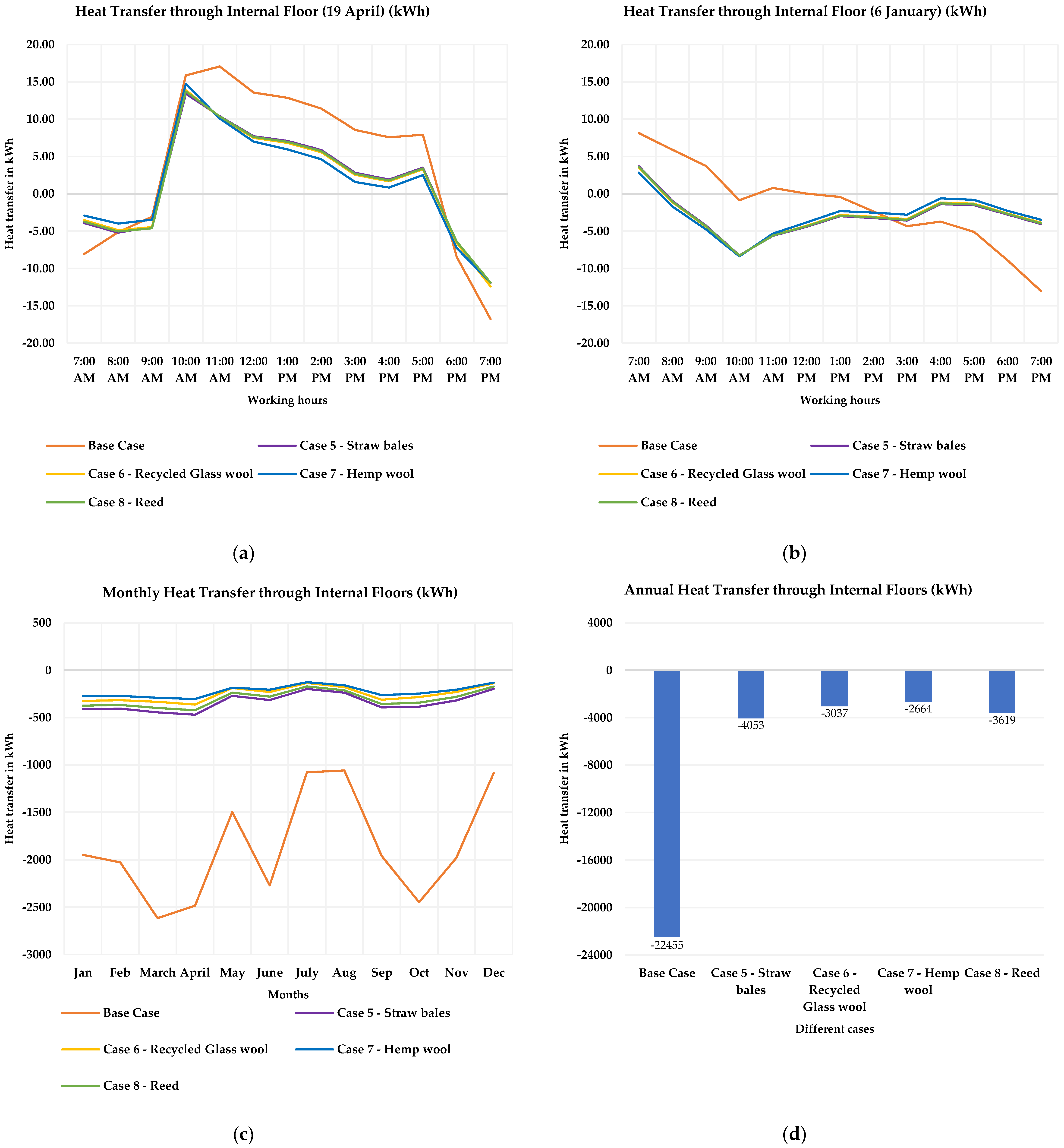

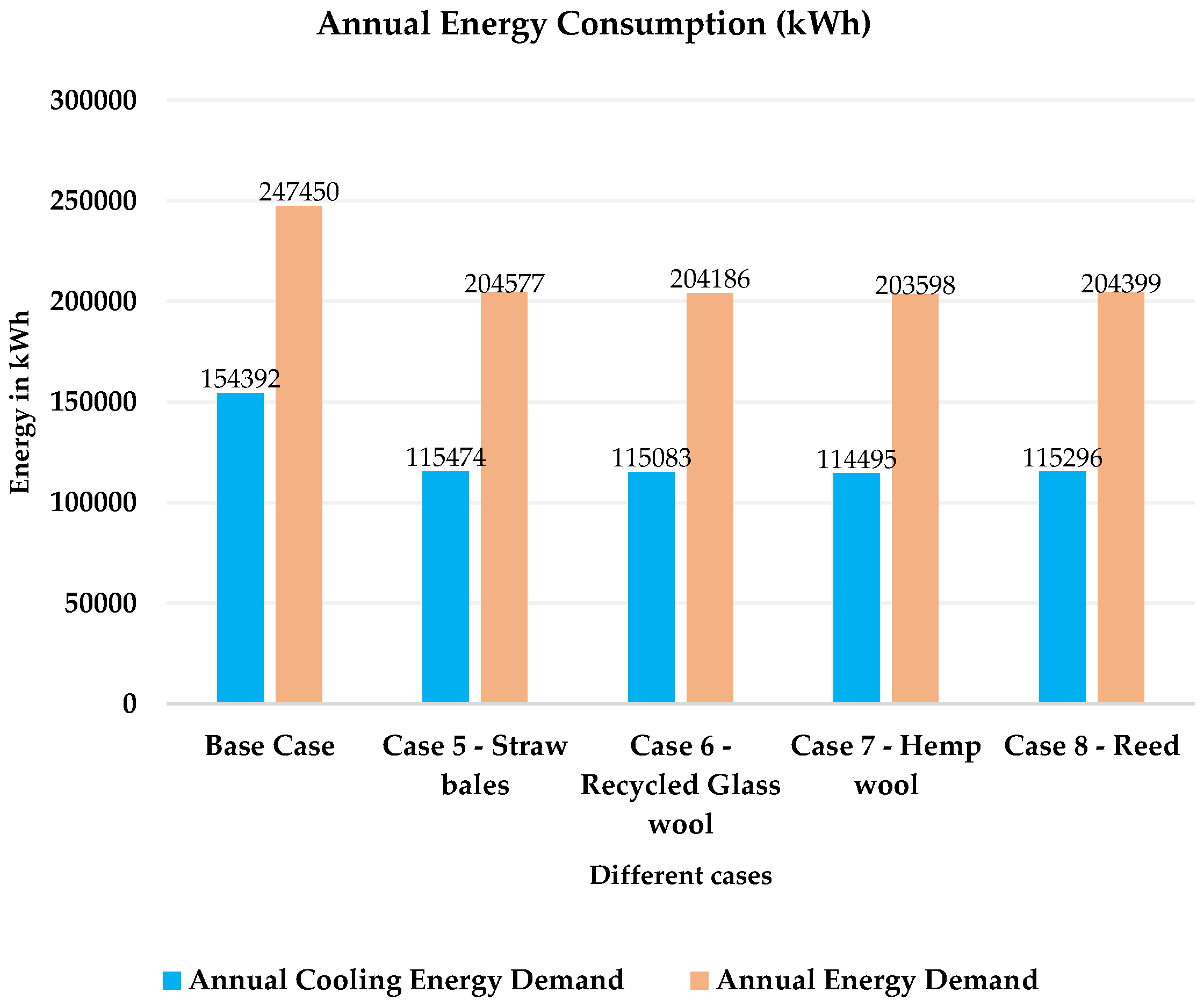
| Office Building Part | Layer Name | Width (mm) | Density (kg/m3) | Specific Heat (J/KgK) | Thermal Conductivity (W/mK) | U-Value (W/m2K) | |
|---|---|---|---|---|---|---|---|
| Ground floor (same for all the cases) | Ceramic tile | 10 | 2390 | 730 | 1.5 | 0.702 | |
| Cement screed | 20 | 2000 | 656.9 | 0.753 | |||
| Soil | 1000 | 1300 | 1046 | 0.837 | |||
| Base model | Roof | Concrete slab | 200 | 2400 | 1000 | 1.13 | 1.488 |
| Air gap | 400 | ||||||
| Gypsum plasterboard | 20 | 800 | 1090 | 0.16 | |||
| Wall | Ext coating: Cement and plaster | 10 | 1858 | 1000 | 0.9 | 2.89 | |
| Hollow concrete block | 200 | 2200 | 1008 | 1.3 | |||
| Int coating: Cement and plaster | 10 | 1858 | 1000 | 0.9 | |||
| Internal Floor | Ceramic tiles | 10 | 2390 | 730 | 1.5 | 1.237 | |
| Concrete slab | 200 | 2400 | 1000 | 1.13 | |||
| Air gap | 400 | ||||||
| Gypsum plasterboard | 20 | 800 | 1090 | 0.16 | |||
| First round: Wall insulation | |||||||
| Case 1: Straw bales | Wall | Exterior coating: Clay | 30 | 1600 | 878 | 0.8 | 0.274 |
| XPS extruded polystyrene | 10 | 35 | 1400 | 0.034 | |||
| Straw bales | 160 | 100 | 1700 | 0.06 | |||
| Hollow concrete block | 100 | 2200 | 1008 | 1.3 | |||
| XPS extruded polystyrene | 10 | 35 | 1400 | 0.034 | |||
| Interior coating: Clay | 30 | 1600 | 878 | 0.8 | |||
| Case 2: Recycled glass wool | Wall | Exterior coating: Clay | 30 | 1600 | 878 | 0.8 | 0.208 |
| XPS extruded polystyrene | 10 | 35 | 1400 | 0.034 | |||
| Recycled glass wool | 160 | 150 | 1000 | 0.042 | |||
| Hollow concrete block | 100 | 2200 | 1008 | 1.3 | |||
| XPS extruded polystyrene | 10 | 35 | 1400 | 0.034 | |||
| Interior coating: Clay | 30 | 1600 | 878 | 0.8 | |||
| Case 3: Hemp wool | Wall | Exterior coating: Clay | 30 | 1600 | 878 | 0.8 | 0.18 |
| XPS extruded polystyrene | 10 | 35 | 1400 | 0.034 | |||
| Hemp wool | 160 | 30 | 1300 | 0.035 | |||
| Hollow concrete block | 100 | 2200 | 1008 | 1.3 | |||
| XPS extruded polystyrene | 10 | 35 | 1400 | 0.034 | |||
| Interior coating: Clay | 30 | 1600 | 878 | 0.8 | |||
| Case 4: Reed | Wall | Exterior coating: Clay | 30 | 1600 | 878 | 0.8 | 0.246 |
| XPS extruded polystyrene | 10 | 35 | 1400 | 0.034 | |||
| Reed | 160 | 130 | 1200 | 0.052 | |||
| Hollow concrete block | 100 | 2200 | 1008 | 1.3 | |||
| XPS extruded polystyrene | 10 | 35 | 1400 | 0.034 | |||
| Interior coating: Clay | 30 | 1600 | 878 | 0.8 | |||
| Second round: Roof and Internal Floor insulation | |||||||
| Case 5: Straw bales | Roof | Clay | 50 | 1600 | 878 | 0.8 | 0.207 |
| Concrete slab | 200 | 2400 | 1000 | 1.13 | |||
| XPS extruded polystyrene | 10 | 35 | 1400 | 0.034 | |||
| Straw bales | 160 | 100 | 1700 | 0.06 | |||
| Air gap | 400 | ||||||
| XPS extruded polystyrene | 10 | 35 | 1400 | 0.034 | |||
| Straw bales | 50 | 100 | 1700 | 0.06 | |||
| Gypsum plasterboard | 20 | 800 | 1090 | 0.16 | |||
| Internal Floor | Ceramic tile | 10 | 2390 | 730 | 1.5 | 0.204 | |
| Concrete slab | 200 | 2400 | 1000 | 1.13 | |||
| XPS extruded polystyrene | 10 | 35 | 1400 | 0.034 | |||
| Straw bales | 160 | 100 | 1700 | 0.06 | |||
| Air gap | 400 | ||||||
| XPS extruded polystyrene | 10 | 35 | 1400 | 0.034 | |||
| Straw bales | 50 | 100 | 1700 | 0.06 | |||
| Gypsum plasterboard | 20 | 800 | 1090 | 0.16 | |||
| Case 6: Recycled glass wool | Roof | Clay | 50 | 1600 | 878 | 0.8 | 0.158 |
| Concrete slab | 200 | 2400 | 1000 | 1.13 | |||
| XPS extruded polystyrene | 10 | 35 | 1400 | 0.034 | |||
| Recycled glass wool | 160 | 150 | 1000 | 0.042 | |||
| Air gap | 400 | ||||||
| XPS extruded polystyrene | 10 | 35 | 1400 | 0.034 | |||
| Recycled glass wool | 50 | 150 | 1000 | 0.042 | |||
| Gypsum plasterboard | 20 | 800 | 1090 | 0.16 | |||
| Internal Floor | Ceramic tile | 10 | 2390 | 730 | 1.5 | 0.156 | |
| Concrete slab | 200 | 2400 | 1000 | 1.13 | |||
| XPS extruded polystyrene | 10 | 35 | 1400 | 0.034 | |||
| Recycled glass wool | 160 | 150 | 1000 | 0.042 | |||
| Air gap | 400 | ||||||
| XPS extruded polystyrene | 10 | 35 | 1400 | 0.034 | |||
| Recycled glass wool | 50 | 150 | 1000 | 0.042 | |||
| Gypsum plasterboard | 20 | 800 | 1090 | 0.16 | |||
| Case 7: Hemp wool | Roof | Clay | 50 | 1600 | 878 | 0.8 | 0.137 |
| Concrete slab | 200 | 2400 | 1000 | 1.13 | |||
| XPS extruded polystyrene | 10 | 35 | 1400 | 0.034 | |||
| Hemp wool | 160 | 30 | 1300 | 0.035 | |||
| Air Gap | 400 | ||||||
| XPS extruded polystyrene | 10 | 35 | 1400 | 0.034 | |||
| Hemp wool | 50 | 30 | 1300 | 0.035 | |||
| Gypsum plasterboard | 20 | 800 | 1090 | 0.16 | |||
| Internal Floor | Ceramic tile | 10 | 2390 | 730 | 1.5 | 0.135 | |
| Concrete slab | 200 | 2400 | 1000 | 1.13 | |||
| XPS extruded polystyrene | 10 | 35 | 1400 | 0.034 | |||
| Hemp wool | 160 | 30 | 1300 | 0.035 | |||
| Air gap | 400 | ||||||
| XPS extruded polystyrene | 10 | 35 | 1400 | 0.034 | |||
| Hemp wool | 50 | 30 | 1300 | 0.035 | |||
| Gypsum plasterboard | 20 | 800 | 1090 | 0.16 | |||
| Case 8: Reed | Roof | Clay | 50 | 1600 | 878 | 0.8 | 0.187 |
| Concrete slab | 200 | 2400 | 1000 | 1.13 | |||
| XPS extruded polystyrene | 10 | 35 | 1400 | 0.034 | |||
| Reed | 160 | 130 | 1200 | 0.052 | |||
| Air gap | 400 | ||||||
| XPS extruded polystyrene | 10 | 35 | 1400 | 0.034 | |||
| Reed | 50 | 130 | 1200 | 0.052 | |||
| Gypsum plasterboard | 20 | 800 | 1090 | 0.16 | |||
| Internal Floor | Ceramic tile | 10 | 2390 | 730 | 1.5 | 0.184 | |
| Concrete slab | 200 | 2400 | 1000 | 1.13 | |||
| XPS extruded polystyrene | 10 | 35 | 1400 | 0.034 | |||
| Reed | 160 | 130 | 1200 | 0.052 | |||
| Air Gap | 400 | ||||||
| XPS extruded polystyrene | 10 | 35 | 1400 | 0.034 | |||
| Reed | 50 | 130 | 1200 | 0.052 | |||
| Gypsum plasterboard | 20 | 800 | 1090 | 0.16 | |||
| Input Parameters | Base Case | First Round Simulations | Second Round Simulations | ||||||
|---|---|---|---|---|---|---|---|---|---|
| Case 1: Straw Bales | Case 2: Recycled Glass Wool | Case 3: Hemp Wool | Case 4: Reed | Case 5: Straw Bales | Case 6: Recycled Glass Wool | Case 7: Hemp Wool | Case 8: Reed | ||
| Wall U-value | 2.89 W/m2K | 0.274 W/m2K | 0.208 W/m2K | 0.18 W/m2K | 0.246 W/m2K | Best-performing wall from Case 1 to 4 | |||
| Roof and ceiling U-value | 1.488 | 0.207 W/m2K | 0.158 W/m2K | 0.137 W/m2K | 0.187 W/m2K | ||||
| Internal floor and ceiling U-value | 0.204 W/m2K | 0.156 W/m2K | 0.135 W/m2K | 0.184 W/m2K | |||||
| Ground floor U-value | 0.702 W/m2K | ||||||||
| WWR | 30% | ||||||||
| Shading | Horizontal louvers: with a depth of 0.25 m, the spacing between two louvers of 0.5 m/angle was kept at 0° | ||||||||
| Glazing | Single Ref A L blue-tinted 6 mm glazing: 4.885 W/m2K | ||||||||
| SHGC | Single Ref A L blue-tinted 6 mm glazing: 0.174 | ||||||||
| VLT | Single Ref A L blue-tinted 6 mm glazing: 0.05 | ||||||||
| Ventilation | On | ||||||||
| Infiltration | 0.7 | ||||||||
| HVAC | Split system | ||||||||
| System CoP | 3.5 | ||||||||
| Set point | 22 °C | ||||||||
| Set back | 28 °C | ||||||||
| Supply air | 12 °C | ||||||||
| Dehumidification | On | ||||||||
| Schedule | 7 a.m. to 8 a.m.: 25% of occupancy | ||||||||
| 8 a.m. to 9 a.m.: 50% of occupancy | |||||||||
| 9 a.m. to 12 p.m.: 100% of occupancy | |||||||||
| 12 p.m. to 2 p.m.: 75% of occupancy | |||||||||
| 2 p.m. to 5 p.m.: 100% Occupancy | |||||||||
| 5 p.m. to 6 p.m.: 50% Occupancy | |||||||||
| 6 p.m. to 7 p.m.: 25% of occupancy | |||||||||
| 7 p.m. to 7 a.m.: Unoccupied | |||||||||
| Density | 1 person/10 m2 | ||||||||
| Clothing | 1 clo for winter/0.5 clo for summer | ||||||||
| Lighting | 12 W/m2 with 300 lux of illuminance | ||||||||
| Equipment | 15 W/m2 | ||||||||
| People load | 140 W/m2 | ||||||||
| Climate data | Weather data summary of Ouagadougou, Burkina Faso. Epw file from 2004 to 2018 Source: Climate Consultant (developed by UCLA Energy Design Tools Group, © Regents of the University of California) | ||||||||
| Parameters to compare | Cooling energy demand | ||||||||
| Energy consumption | |||||||||
| Heat transfer | |||||||||
| Discomfort degree hours | |||||||||
| Strategies | Implementing Solutions |
|---|---|
| Conservation of natural resources through regulating limited stocks and balancing renewable resource flows |
|
| Optimize resource outputs by continuously recirculating products, components, and materials at their greatest usefulness in both technological and biological cycles. |
|
| Drive system efficiency by exposing and designing negative externalities |
|
Disclaimer/Publisher’s Note: The statements, opinions and data contained in all publications are solely those of the individual author(s) and contributor(s) and not of MDPI and/or the editor(s). MDPI and/or the editor(s) disclaim responsibility for any injury to people or property resulting from any ideas, methods, instructions or products referred to in the content. |
© 2023 by the authors. Licensee MDPI, Basel, Switzerland. This article is an open access article distributed under the terms and conditions of the Creative Commons Attribution (CC BY) license (https://creativecommons.org/licenses/by/4.0/).
Share and Cite
Zoure, A.N.; Genovese, P.V. Comparative Study of the Impact of Bio-Sourced and Recycled Insulation Materials on Energy Efficiency in Office Buildings in Burkina Faso. Sustainability 2023, 15, 1466. https://doi.org/10.3390/su15021466
Zoure AN, Genovese PV. Comparative Study of the Impact of Bio-Sourced and Recycled Insulation Materials on Energy Efficiency in Office Buildings in Burkina Faso. Sustainability. 2023; 15(2):1466. https://doi.org/10.3390/su15021466
Chicago/Turabian StyleZoure, Abraham Nathan, and Paolo Vincenzo Genovese. 2023. "Comparative Study of the Impact of Bio-Sourced and Recycled Insulation Materials on Energy Efficiency in Office Buildings in Burkina Faso" Sustainability 15, no. 2: 1466. https://doi.org/10.3390/su15021466
APA StyleZoure, A. N., & Genovese, P. V. (2023). Comparative Study of the Impact of Bio-Sourced and Recycled Insulation Materials on Energy Efficiency in Office Buildings in Burkina Faso. Sustainability, 15(2), 1466. https://doi.org/10.3390/su15021466







